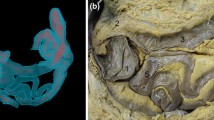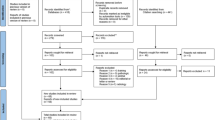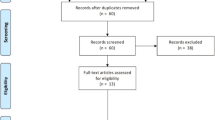Abstract
Background
Medical three-dimensional (3D) digital reconstruction and printing have become common tools in medicine, but few undergraduate medical students understand its whole process and teaching and clinical application. Therefore, we designed an elective course of 3D reconstruction and printing for students and studied its significance and practicability.
Methods
Thirty undergraduate medical students in their second-year of study volunteered to participate in the course. The course started with three lessons on the theory of 3D digital reconstruction and printing in medicine. The students were then randomly divided into ten groups. Each group randomly selected its own original data set, which could contain a series of 2D images including sectional anatomical images, histological images, CT and MRI. Amira software was used to segment the structures of interest, to 3D reconstruct them and to smooth and simplify the models. These models were 3D printed and post-processed. Finally, the 3D digital and printed models were scored, and the students produced brief reports of their work and knowledge acquisition and filled out an anonymous questionnaire about their study perceptions.
Results
All the students finished this course. The average score of the 30 students was 83.1 ± 2.7. This course stimulated the students' learning interest and satisfied them. It was helpful for undergraduate students to understand anatomical structures and their spatial relationship more deeply. Students understood the whole process of 3D reconstruction and printing and its teaching and clinical applications through this course.
Conclusion
It is significant and necessary to develop this course for undergraduate medical students.






Similar content being viewed by others
References
Abou Hashem Y, Dayal M, Savanah S, Štrkalj G (2015) The application of 3D printing in anatomy education. Med Educ Online 20:29847
AlAli AB, Griffin MF, Calonge WM, Butler PE (2018) Evaluating the use of cleft lip and palate 3D-printed models as a teaching aid. J Surg Educ 75:200–208
Anderson PA (2017) Clinical applications of 3D printing. Spine (Phila Pa 1976) 42:S30–S31
Belt THVD, Nijmeijer H, Grim D, Engelen LJ, Vreeken R, Gelder MMV, Laan MT (2018) Patient specific actual size 3D printed models for patient education in glioma treatment: first experiences. World Neurosurg 117:e99–e105
Bergman EM (2015) Discussing dissection in anatomy education. Perspect Med Educ 4:211–213
Bernhard JC, Isotani S, Matsugasumi T, Duddalwar V, Hung AJ, Suer E, Baco E, Satkunasivam R, Djaladat H, Metcalfe C, Hu B, Wong K, Park D, Nguyen M, Hwang D, Bazargani ST, de Castro Abreu AL, Aron M, Ukimura O, Gill IS (2016) Personalized 3D printed model of kidney and tumor anatomy: a useful tool for patient education. World J Urol 34:337–345
Cai H (2015) Application of 3D printing in orthopedics: status quo and opportunities in China. Ann Transl Med 3:S12
Chao I, Young J, Coles-Black J, Chuen J, Weinberg L, Rachbuch C (2017) The application of three-dimensional printing technology in anaesthesia: a systematic review. Anaesthesia 72:641–650
Chen S, Pan Z, Wu Y, Gu Z, Li M, Liang Z, Zhu H, Yao Y, Shui W, Shen Z, Zhao J, Pan H (2017) The role of three-dimensional printed models of skull in anatomy education: a randomized controlled trail. Sci Rep 7:575
Chou PY, Hallac RR, Shih E, Trieu J, Penumatcha A, Das P, Meyer CA, Seaward JR, Kane AA (2018) 3D-printed models of cleft lip and palate for surgical training and patient education. Cleft Palate Craniofac J 55:323–327
Costello JP, Olivieri LJ, Krieger A, Thabit O, Marshall MB, Yoo SJ, Kim PC, Jonas RA, Nath DS (2014) Utilizing three-dimensional printing technology to assess the feasibility of high-fidelity synthetic ventricular septal defect models for simulation in medical education. World J Pediatr Congenit Heart Surg 5:421–426
Cui D, Wilson TD, Rockhold RW, Lehman MN, Lynch JC (2017) Evaluation of the effectiveness of 3D vascular stereoscopic models in anatomy instruction for first year medical students. Anat Sci Educ 10:34–45
de Bakker BS, de Jong KH, Hagoort J, de Bree K, Besselink CT, de Kanter FE, Veldhuis T, Bais B, Schildmeijer R, Ruijter JM, Oostra RJ, Christoffels VM, Moorman AF (2016) An interactive three-dimensional digital atlas and quantitative database of human development. Science 354:1019
de Boer BA, van den Berg G, Soufan AT, de Boer PA, Hagoort J, van den Hoff MJ, Moorman AF, Ruijter JM (2012) Measurement and 3D-visualization of cell-cycle length using double labelling with two thymidine analogues applied in early heart development. PLoS ONE 7:e47719
Drake RL, Pawlina W (2015) An addition to the neighborhood: 3D printed anatomy teaching resources. Anat Sci Educ 7:419–419
Flores RL, Liss H, Raffaelli S, Humayun A, Khouri KS, Coelho PG, Witek L (2017) The technique for 3D printing patient-specific models for auricular reconstruction. J Craniomaxillofac Surg 45:937–943
Garas M, Vaccarezza M, Newland G, Mcvay-Doornbusch K, Hasani J (2018) 3D-printed specimens as a valuable tool in anatomy education: a pilot study. Ann Anat 219:57–64
Govsa F, Ozer MA, Sirinturk S, Eraslan C, Alagoz AK (2017) Creating vascular models by postprocessing computed tomography angiography images: a guide for anatomical education. Surg Radiol Anat 39:905–910
Govsa F, Yagdi T, Ozer MA, Eraslan C, Alagoz AK (2017) Building 3D anatomical model of coiling of the internal carotid artery derived from CT angiographic data. Eur Arch Otorhinolaryngol 274:1097–1102
Govsa F, Karakas AB, Ozer MA, Eraslan C (2018) Development of life-size patient-specific 3D-printed dural venous models for preoperative planning. World Neurosurg 110:e141–e149
Govsa F, Ozer MA, Biceroglu H, Karakas AB, Cagli S, Eraslan C, Alagoz AK (2018) Creation of 3-dimensional life size: patient-specific C1 fracture models for screw fixation. World Neurosurg 114:e173–e181
Groenendyk M, Gallant R (2013) 3D printing and scanning at the Dalhousie University Libraries: a pilot project. Lib Hi Tech 31:34–41
Karakas AB, Govsa F, Ozer MA, Eraslan C (2018) 3D brain imaging in vascular segmentation of cerebral venous sinuses. J Digit Imaging 2018:1–8
Kong X, Nie L, Zhang H, Wang Z, Ye Q, Tang L, Huang W, Li J (2016) Do 3D printing models improve anatomical teaching about hepatic segments to medical students? A randomized controlled study. World J Surg 40:1969–1976
Langridge B, Momin S, Coumbe B, Woin E, Griffin M, Butler P (2017) Systematic review of the use of 3-dimensional printing in surgical teaching and assessment. J Surg Educ 75:209–221
Li J, Nie L, Li Z, Lin L, Tang L, Ouyang J (2012) Maximizing modern distribution of complex anatomical spatial information: 3D reconstruction and rapid prototype production of anatomical corrosion casts of human specimens. Anat Sci Educ 5:330–339
Li Z, Tang J, Wang H, Li L, Wu W, Hou S (2016) Exploration of 3D printing technology applied in orthopedic clinical teaching. China Med Educ Tech 30:198–200
Loke YH, Harahsheh AS, Krieger A, Olivieri LJ (2017) Usage of 3D models of tetralogy of Fallot for medical education: impact on learning congenital heart disease. BMC Med Educ 17:54
Ma JL, Ma LM, Wang ZF, Zhu XJ, Wang WJ (2017) The use of 3D-printed titanium mesh tray in treating complex comminuted mandibular fractures. Medicine 96:27
Mafeld S, Nesbitt C, McCaslin J, Bagnall A, Davey P, Bose P, Williams R (2017) Three-dimensional (3D) printed endovascular simulation models: a feasibility study. Ann Transl Med 5:42
Matthews F, Messmer P, Raikov V, Wanner GA, Jacob AL, Regazzoni P, Egli A (2009) Patient-specific three-dimensional composite bone models for teaching and operation planning. J Digit Imaging 22:473–482
McLachlan JC, Bligh J, Bradley P, Searle J (2004) Teaching anatomy without cadavers. Med Educ 38:418–424
McLachlan JC, Patten D (2010) Anatomy teaching: ghosts of the past, present and future. Med Educ 40:243–253
McMenamin PG, Quayle MR, McHenry CR, Adams JW (2014) The production of anatomical teaching resources using three-dimensional (3D) printing technology. Anat Sci Educ 7:479–486
Michalski MH, Ross JS (2014) The shape of things to come: 3D printing in medicine. JAMA 312:2213–2214
Mishra S (2016) Application of 3D printing in medicine. Indian Heart J 68:108–109
Naftulin JS, Kimchi EY, Cash SS (2015) Streamlined, inexpensive 3D printing of the brain and skull. PLoS ONE 10:e0136198
O'Reilly MK, Reese S, Herlihy T, Geoghegan T, Cantwell CP, Feeney RN, Jones JF (2016) Fabrication and assessment of 3D printed anatomical models of the lower limb for anatomical teaching and femoral vessel access training in medicine. Anat Sci Educ 9:71–79
Smith CF, Tollemache N, Covill D, Johnston M (2018) Take away body parts! An investigation into the use of 3D-printed anatomical models in undergraduate anatomy education. Anat Sci Educ 11:44–53
Su W, Xiao Y, He S, Huang P, Deng X (2018) Three-dimensional printing models in congenital heart disease education for medical students: a controlled comparative study. BMC Med Educ 18:178
Tack P, Victor J, Gemmel P, Annemans L (2016) 3D-printing techniques in a medical setting: a systematic literature review. Biomed Eng Online 15:115
Torres K, Staśkiewicz G, Śnieżyński M, Drop A, Maciejewski R (2011) Application of rapid prototyping techniques for modelling of anatomical structures in medical training and education. Folia Morphol 70:1–4
Vaccarezza M, Papa V (2015) 3D printing: a valuable resource in human anatomy education. Anat Sci Int 90:64–65
Wong KC (2016) 3D-printed patient-specific applications in orthopedics. Orthop Res Rev 8:57–66
Wu Y, Dabhoiwala NF, Hagoort J, Shan JL, Tan LW, Fang BJ, Zhang SX, Lamers WH (2015) 3D topography of the young adult anal sphincter complex reconstructed from undeformed serial anatomical sections. PLoS ONE 10:e0132226
Xu N, Wei F, Liu X, Jiang L, Cai H, Li Z, Yu M, Wu F, Liu Z (2016) Reconstruction of the upper cervical spine using a personalized 3B-printed vertebral body in an adolescent with Ewing sarcoma. Spine (Phila Pa 1976) 41:E50–E54
Yammine K, Violato C (2015) A meta-analysis of the educational effectiveness of three-dimensional visualization technologies in teaching anatomy. Anat Sci Educ 8:525–538
Funding
This study was funded by the National Natural Science Foundation of China (31771324), the National Key Research and Development Program of China (2016YFC0106402), the Graduate Education and Teaching Reform Research Project of Chongqing (yjg183144) and the Military Youth Science Foundation of China (16QNP100).
Author information
Authors and Affiliations
Contributions
XZ: data analysis; manuscript writing. ZX: data collection; teaching. LT: teaching guidance. YL: provision of materials and literature search. LL: statistical expertise. NC: data collection. SZ: teaching guidance. WL: conception and design. CW: provision of materials. YW: course design; teaching.
Corresponding author
Ethics declarations
Conflict of interest
The authors declare that they have no conflict of interest.
Ethical approval
All CVH cadavers were enrolled in the body donation program of the CVH project, which follows the scientific and ethical rules of the Army Medical University (Third Military Medical University). The study was approved by the Ethics Committee of the Army Medical University (Third Military Medical University). Patient consent was provided for the use of their (anonymous) CT and MRI images. The histological section images were obtained in accordance with the Dutch regulations for the proper use of human and animal tissue for medical research purposes. The anonymous specimens, which belong to the historical collection of human embryos at the Department of Anatomy and Embryology, Leiden University Medical Center, Leiden, the Netherlands, had been donated for scientific research. The Leiden collection was established in the 1950–1970s. In the Netherlands, the study of historical collections is exempt from approval by a medical ethics committee.
Informed consent
Informed consent was obtained from all individual participants included in the study.
Additional information
Publisher's Note
Springer Nature remains neutral with regard to jurisdictional claims in published maps and institutional affiliations.
Rights and permissions
About this article
Cite this article
Zhang, X., Xu, Z., Tan, L. et al. Application of three-dimensional reconstruction and printing as an elective course for undergraduate medical students: an exploratory trial. Surg Radiol Anat 41, 1193–1204 (2019). https://doi.org/10.1007/s00276-019-02248-1
Received:
Accepted:
Published:
Issue Date:
DOI: https://doi.org/10.1007/s00276-019-02248-1




